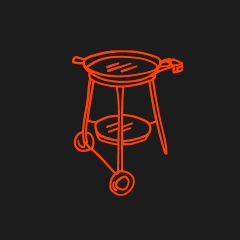Paella Dictionary
Paella and Paella Pans
From synonyms to popular, personal or even invented expressions, there are many ways to call the things around us, each with its own meanings and origins. Any chef or professional cook can tell you that in the world of cooking there are also thousands of ways to call a single thing.
Paella is no exception, the different localities and their inhabitants have very varied and colorful ways of referring to everything that surrounds this magnificent dish, not only to refer to the necessary equipment, but even to methods or ingredients.
In this blog entry we are going to collect all those that we know and that we did not know until now, this way, wherever you are, you will know when someone is referring to something related to paella.
Organization of the paella dictionary
To facilitate the comprehension of this paella dictionary, we will divide the different words by its main word in alphabetical form, followed by its possible synonyms and meanings, we will include within this main word related words or derived from the same one.
Paella and Paellera
There has always been the debate of what it is called (paella or paellera) in this blog we resolve that discussion.
Many people know how they want to make their paella but we don't know what size is necessary for those people, in this blog we explain you with a table the portions that come out of each size of paella and the thickness of the rice layer.
Paella:
Recipe with rice base with origin in the Valencian Community.
Container normally used for the preparation of paella.
Paella pan:
Pertaining or relating to paella.
Said of a person: Who makes paellas
A metal container, like a frying pan, with a shallow bottom and handles, used to make paella.
If you want more in depth information about each type of paella you can visit this blog
Polished steel paella or traditional paella:
Popularly referred to as the classic paella, it is forged entirely of steel, thanks to this it quickly disperses heat across its entire surface, it is slightly convex and its sides are sloped to make the first stages of the preparation of the paella easier, it is prone to rust so it is necessary to perform a much more precise maintenance.
If you have doubts about how to maintain a paella you can enter this blog entry.
Enameled Paella:
Also referred to by the synonym of black paella or popularly as "paella with polka dots" or "paella with white dots", it has a characteristic black enamel layer and usually with white dots that helps to not having to perform hardly maintenance and in turn reduces the effort that has to be done to clean it, that layer of enamel also makes it resistant to rust.
The most important thing when cleaning the paella is to know how to do it to avoid damaging it, in this blog we teach you the right method to clean it.
Stainless steel paella pan:
It is the type of paella with the best characteristics, it combines the aesthetic benefits of the polished steel paella and the antioxidant capabilities of the enameled paella without adding any disadvantage, it only requires cleaning with soap and water.
Special thickness paella pan or professional paella pan:
Also referred to as paella de pata negra, with similar qualities to a polished steel paella pan, but with the addition of a greater thickness in the plate, which allows them to be very resistant to fire and deformation, making them ideal for wood fires.
Paella pan with special thickness
Induction paella or paella pans for glass-ceramic hobs:
They are manufactured specifically for use on glass-ceramic or induction hobs, they are perfectly flat paella pans to have the largest contact surface, there are several types such as polished steel, enameled and stainless steel paella pans, they also have a reinforced bottom as they need to be more resistant because induction and glass-ceramic hobs are more aggressive than traditional gas fires.
The number of induction paella options can be confusing but in this blog we discuss all varieties of induction paella.
Many people claim that paella on induction heat does not work well, more information in this blog.
Multitasting Paellas:
They are paellas with divisions so that several dishes can be prepared in the same container at the same time, they are enameled paellas and can have 2 or 3 divisions, depending on the amount of paellas we want to prepare in one sitting.
Varieties of Valencian rice / rice for paella.
Rice:
Annual plant typical of very humid soils, whose fruit is an oval grain rich in starch.
There has always been a discussion about whether to wash the rice for paella, in this blog entry we talk in depth about whether to do it or not.
Paella:
Rice-based recipe originating in the Valencian community.
Container that is normally used to make paella, also known as a paella pan.
Polished steel paella or traditional paella pan:
It is forged entirely of steel, thanks to which it quickly disperses heat across its entire surface, it is slightly convex and its sides are inclined to make the first stages of paella preparation easier, it is prone to rust.

Enameled paella pan:
It is the second most famous type of paella, it has a characteristic black glaze layer and usually with white dots that helps to avoid having to carry out hardly any maintenance.

Stainless steel paella pan:
It is the type of paella with the best characteristics, it combines the benefits of polished steel and enameled paella without adding any disadvantages, it only requires cleaning with soap and water.

Special thickness paella / professional paella pan:
In terms of qualities, it is similar to a polished steel paella pan, but with the addition of a greater thickness in the sheet, which allows them to be very resistant to fire and deformation.

Induction paella pans:
They are manufactured specifically for use on ceramic or induction hobs, they are perfectly flat paella pans to have the largest contact surface, there are several types such as normal paella pans, polished steel, enameled and stainless steel.
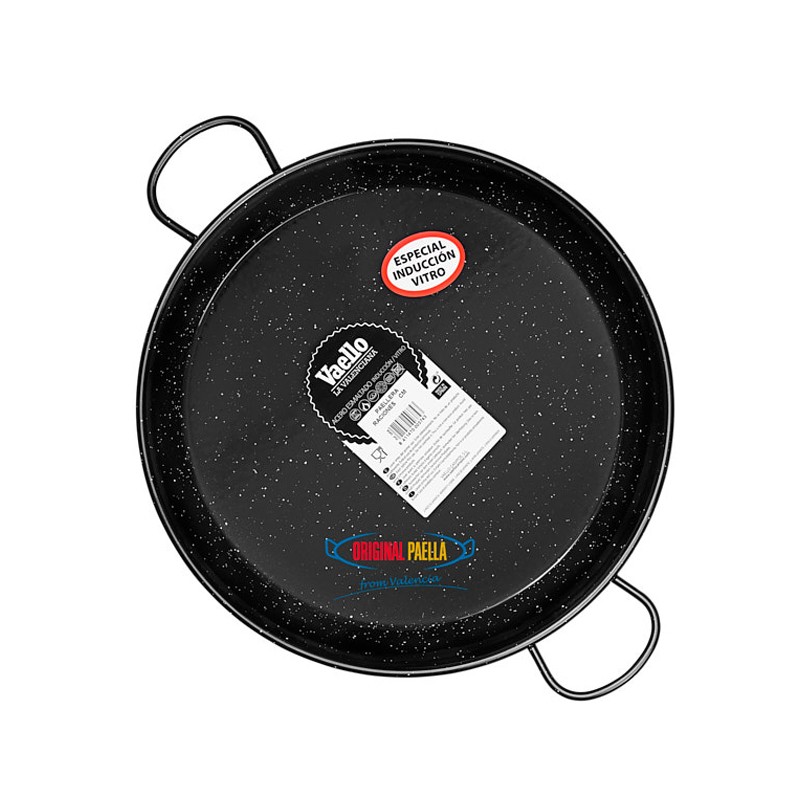
Multitaste Paella pans:
They are paella pans with divisions so that several dishes can be prepared in the same container at the same time, they are enameled paellas and can have 2 or 3 divisions.

Varieties of Valencian rice/ paella rice
Bomba rice:
It is the most recent variety of rice to emerge, it is slightly smaller in size than a common grain, its greatest advantage over other varieties is its resistance to overcooking, making it easier to work with for people with Little experience in the world of rice regardless of the dish you are trying to prepare.

Senia rice:
This variety of rice is known for its exceptional ability to absorb the flavors of the broth, but it is also quite prone to overcooking so obtaining good results is difficult for people with little experience as rice cooks.

Maratelli rice:
It is similar to Bomba in the aspect of overcooking, it also has a great capacity to absorb flavors, it is ideal for preparing takeaway dishes as it maintains its maximum flavor for longer.

Albufera Rice:
It is a hybrid rice between Bomba and Senia that has the overcooking capacity of Bomba and also has the great absorption of Senia.
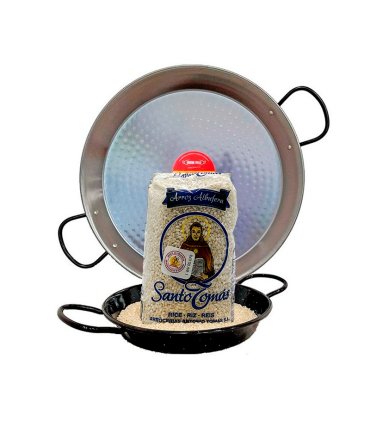
Gas burners/paella pans
Traditional/round gas burners:
Also known as aro, rosco, paella ring or paella stove, these are mainly used for domestic use and have an enamel coating for easy cleaning. This type of burner works with propane, butane and natural gas.

High power/flat tube:
This type of gas burners offer approximately 20% more power than the round ones. They can only be used outdoors because they do not have thermocouple valves. The only way to use them indoors is to have an approved one.
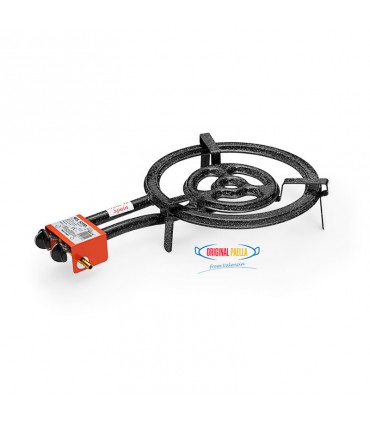
Gas accessories
Gas regulators / gas shower:
They allow us to regulate the flow of the gas that our gas burner is using.

Flexible gas tube:
It is a plastic tube of different lengths that allows us to connect the gas valves we are using to the devices we want to use.
.jpg)
Paella Robot
Mimcook:
The Mimcook smart burner allows people with little experience to make good paellas simply by following the standardized steps that appear on its screen. The robot comes with basic recipes, but you can also have it memorize your own recipes.

Accessories
Pipette:
The paella pipette is used to remove the broth from areas that show excess or that are reaching the point of overcooking.

Paella magnet:
It is used to measure the amount of water we have to add and how much has evaporated to add the rice at the exact moment.

Steel pallets:
It is the favorite utensil for handling the elements inside the paella, they are normally made of stainless steel and may have a wooden handle in some cases.

Windbreak for paella:
Made of galvanized steel, the windbreak is perfect for making a paella when it is windy, it hangs directly from the paella pan and there are several sizes depending on the size of your paella.

Paella cleaner:
The paella cleaner is an incredibly effective degreasing gel that effortlessly removes grease and food remains. It can also be used to remove rust on the surface of the paella.

Paellero lighter / paellero lighter:
It is an accessory that seems simple, but it saves you from possible burns when turning on the gas thread, as it has an extra long rod, it keeps your hand away from the gas to prevent you from suffering any type of burns when you turn on the gas.
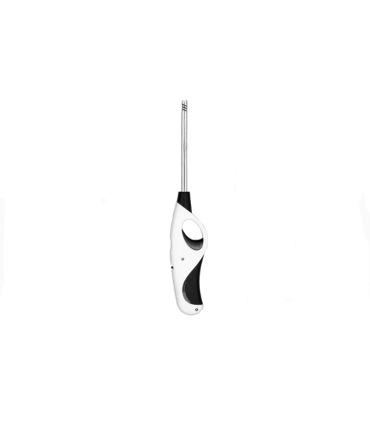
Paella hanger:
Made of stainless steel to last a lifetime, it allows you to store up to 10 paella pans quickly, comfortably and aesthetically.

paella holder / iron holder:
The paella holder is the most elegant and safest way to transport our freshly made paella to our table while avoiding burning ourselves or the table.

Magnetic trivet/mat:
The magnetic trivet helps us preserve our table and tablecloth by sticking under the paella and covering it from the heat.
Adjustable trivet / adjustable mat:
The adjustable trivet is placed between the paella and the table/tablecloth to prevent it from being stained or burned by heat and direct contact.
Wall paella holder / Paella hook:
The paella wall support can carry a maximum of 30 kilos and can hold up to 6 paella pans, made of enamel-coated steel to prevent rust over the years.

Iron paella handles/handles:
A set of extra handles to carry the freshly made paella to avoid burns, universal for all sizes and types of paellas, they are the perfect solution for transporting a freshly made paella from the heat, it is also useful if we need to rotate or move the paella during its preparation.
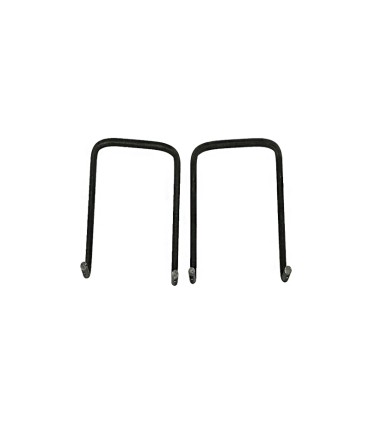
TREBDES AND SUPPORTS FOR PAELLA PANS
Adjustable tripod for paella pan / paella tripod:
A tripod made of aluminum perfect for raising the paella to the height that is most comfortable for us to cook in the most comfortable way possible.

Reinforced legs:
Perfect for stably raising the paella off the floor to make it more convenient and to prevent dust and dirt from the floor.

Adjustable legs for paella:
A set of 3 adjustable steel legs that will help us raise our paella to the point that is most comfortable for us to cook it.

Short adjustable legs:
For situations where there is not much space, with the short paella legs we can raise the table to cook better and separate the paella pan from dirt and the table from the flames.

Mini tripod / mini easel:
Perfect for raising the gas paella pan from the surface so that it does not overheat and for raising the paella pan in case you do not have room to use larger legs.

Trivets / support for paella pan:
Made of cast iron, the trivets have been the most used supports throughout the history of the paella, they are used to raise it to the ideal height for making it with firewood.

Mini leg set:
Perfect for raising the paella pan when you don't have enough space to use a larger stand, but cannot be used with high power burners/flat tube burners.

Grilling plates
Enameled cast iron griddle/iron board:
It is the ideal utensil for cooking things like fish, vegetables or meat thanks to the fact that it spreads heat evenly across its surface.

ECO enameled iron:
It distributes heat evenly and maintains it for a longer time due to its great thickness. It also has handles with a diffuser design to avoid burns when touched.

Paella and rice books
The rice book:
It is a work that is done graphically to make it more educational with 123 rice recipes by Pedro Ponce Palomares, each recipe has its own image, quantities and some tricks for its preparation.
.jpg)
Paellas and much more:
Ximo Carrión's book contains 92 recipes for a wide variety of very detailed paellas and rice dishes, each with its own reference image.

Paella Lovers:
David Montero, also known on social networks as @RicePaella, captures all his knowledge from years of practice as a master rice cook. This book covers not so much the recipes but the bases of every dish that is made from the varieties of rice or ingredients.

Fideua 101:
A book completely dedicated to fideua recipes written by Pedro Ponce, this book not only covers the origins and all the recipes that have emerged from fideua over the years.

Our rice:
Ximo Carrión presents us with a book that fully covers the history, culture and landscape that surrounds rice, at the same time the book also includes some traditional recipes that may be little known.
Olive oil
In paella, it is best to use extra virgin olive oil for a better result and a more intense flavor, not to mention that it is healthier than a more processed oil.

Condiments
Saffron:
It is one of the most classic and well-known ingredients of paella, it is crucial for a good Valencian paella, its flavor and characteristics are what finalizes and changes from a good paella to a tremendous one.

Sweet paprika:
Contrary to popular belief, paprika is not the main option when making a paella. Apart from being an excellent ingredient for paellas, it can be used for many other dishes.

Food coloring:
It serves to give a little more yellowish color to the paella without having to add any extra flavor, it became popular as a substitute ingredient for saffron, but it is always advisable to use saffron, but in case you want to give it a little more color It's not bad to add a little to the dish.

Paella seasoning:
The seasoning for paella is made by mixing spices such as saffron or rosemary, it is used to season the paella before adding the rice, it comes with specified measurements for the portions that we are going to add, which helps us nail the quantity that must be put in to obtain a great flavor.

Seasoning for paellas:
It is mainly used to increase or add to the flavor of any rice dish, commonly paella.

Ñora Pepper:
It's a product that has traditionally been used to make Salmorreta, it is considered an essential ingredient for Alicante rice dishes.

Garrofon
It is a basic of a good Valencian paella, it has a great capacity to absorb flavors, with a creamy texture and a very light purple pigmentation.

kitchen terminology
Section dedicated to the terminology of certain things in recipes.
Socarrat:
Socarrat is the lightly toasted part that is sought to be formed in many recipes, it is created at the bottom of the paella.
.jpg)
Fumet:
It is a broth made from fish and shellfish that is used in many seafood or fish paella recipes.
There is no such thing as a “meat fumet”, fumet is a term used almost exclusively for fish broths.
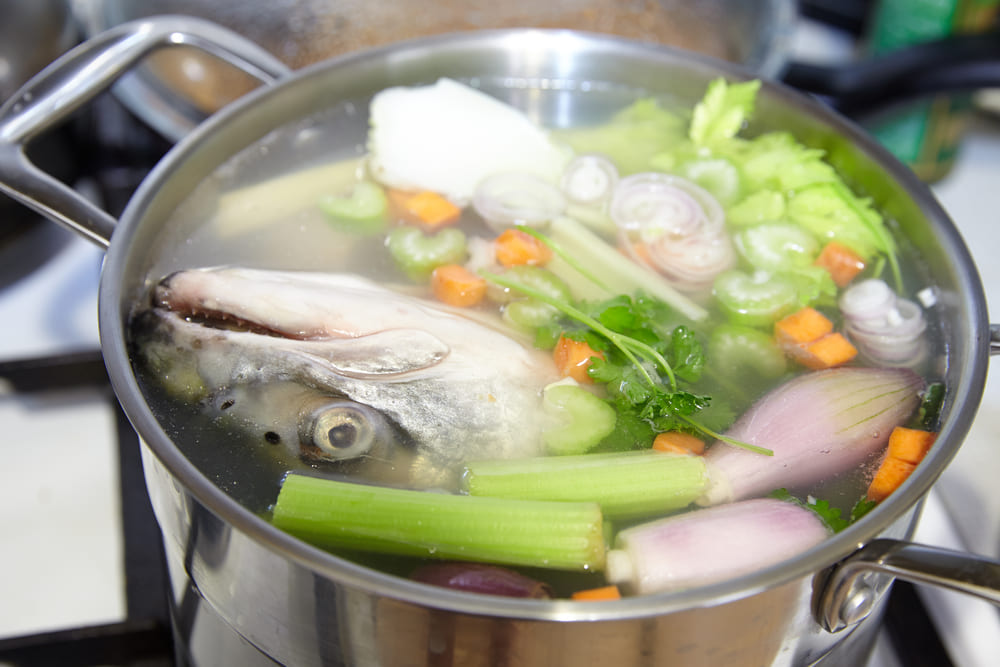
Salmorreta:
It is a special type of stir-fry that is made with ñora pepper and is used in seafood or fish rice and originated in the Alicante area.

Aioli:
It is a sauce that is made in a mortar with garlic, egg and olive oil, it is usually used for dishes such as patatas bravas or to accompany dishes such as arroz a banda or black rice.

Nacarar:
It refers to frying something in oil until it obtains a more orange tone. This term is commonly used in rice dishes.

Sofrito:
It is a fairly general term that is used to describe a base for preparing a dish, it can contain a wide variety of ingredients, but the vast majority includes olive oil.

Infuse the saffron:
It is the action of mixing it with broth or water before adding it to the dish for better integration throughout the dish.

Paella Terminology
Usual expressions used by Valencians when tasting or preparing paella, heard in gatherings among friends or family, in a familiar and friendly environment.
Che que bo! / Això està molt bo / That's so good!
Expression used by the diners when they taste the paella, declaring to all the participants and to the cook that the paella is, without a doubt, very good.
Missing a miqueta
Valencian measure of time used by the cook when the rice is being cooked to indicate the time remaining until the paella is finished. How much time this measure indicates usually varies from cook to cook.
Xe!
A generally pejorative expression used to call attention to a diner who does something he/she shouldn't, although it can also be used to greet a new diner who has just arrived.
Fes el favor!
Notice or request used for a multitude of reasons, whether it be to call attention to something in particular or to request that something be approached/do something.
No sigas fill de puta
Vulgar expression with an affectionate tone, used among close friends in many situations, from taking someone else's ingredients to doubting the taste of the paella being eaten.
Més per així!
Expression that usually ends as a shout that is used to ask for more paella if it has been served on a plate or any ingredient of it, it can also be used to ask for a refill if someone is filling his own glass with a drink that we like.
Estic fart! /No em cap res més!
General expression for all diners to announce that you can't fit a single grain of rice anymore, although everyone knows that something else will be drunk or that you will eat dessert anyway.
Sen va a gelar!
A call generally shouted to be heard by those who are not near the paella, used to imply that enough talking or snacking is enough, because the paella is ready and on the table.
Aixó per a tu
Multi-meaning expression that changes by the context, generally used to give a diner an ingredient that we don't want, sometimes warned in advance, many others throwing or approaching the ingredient before even using this phrase.

